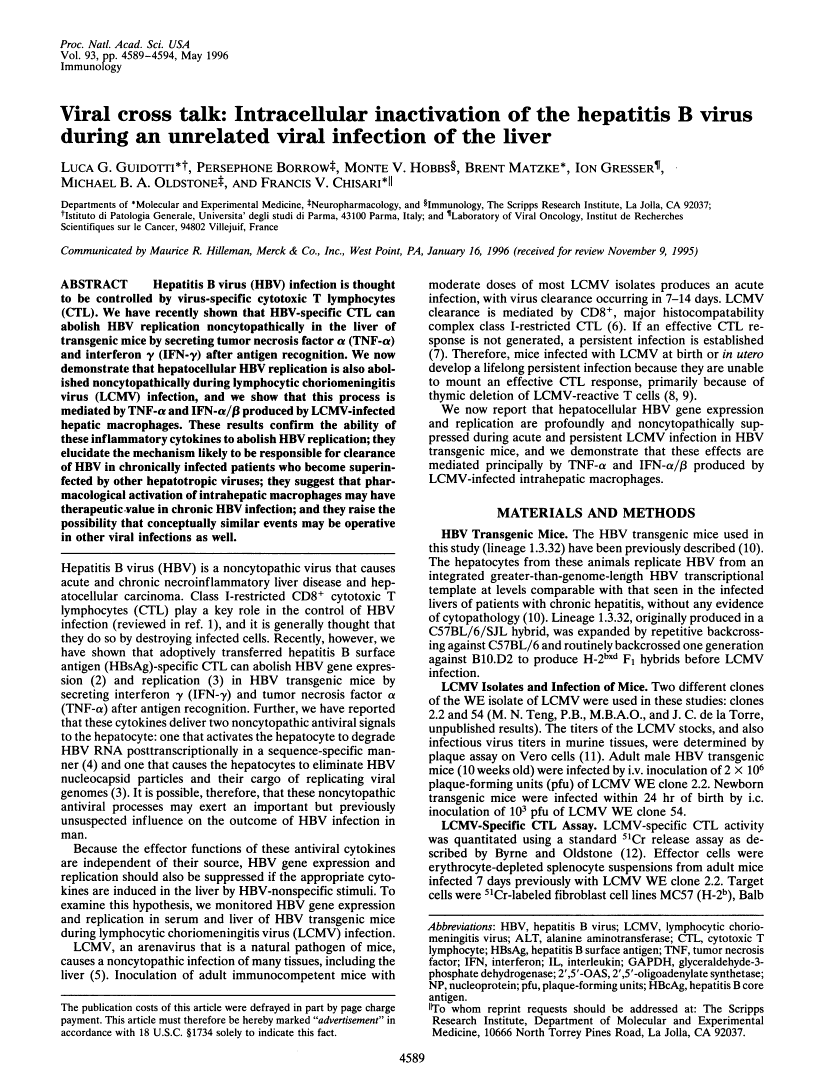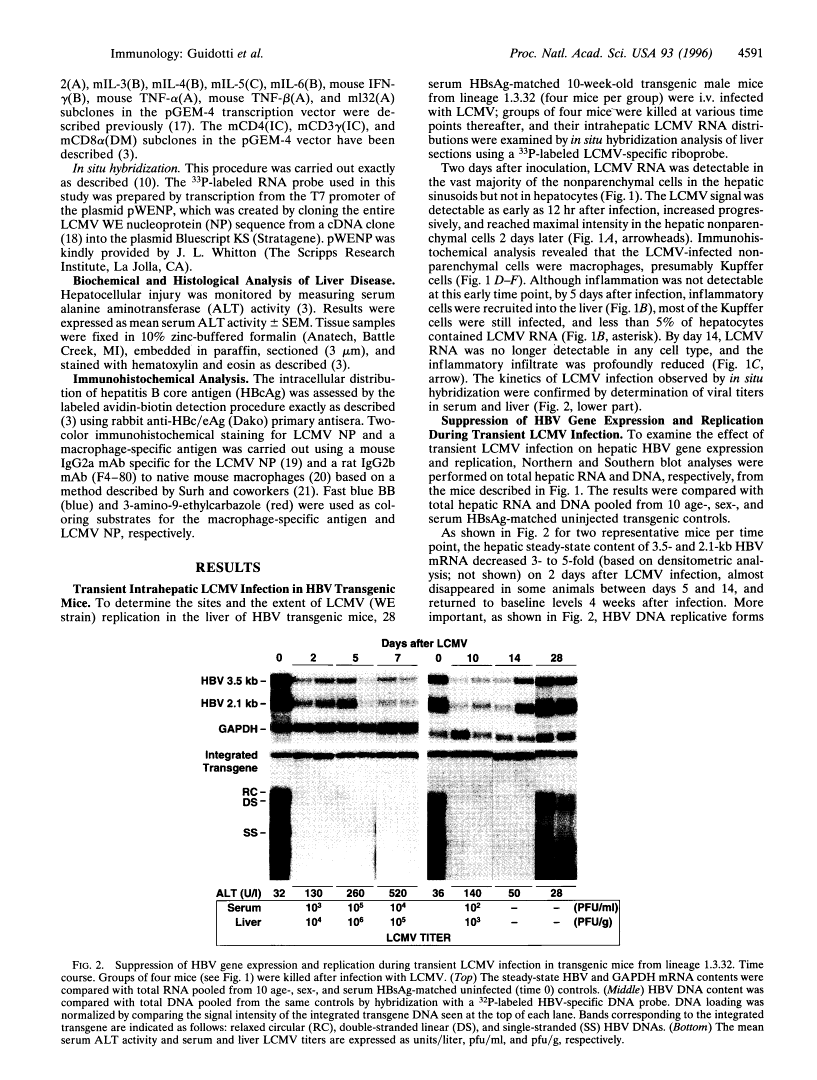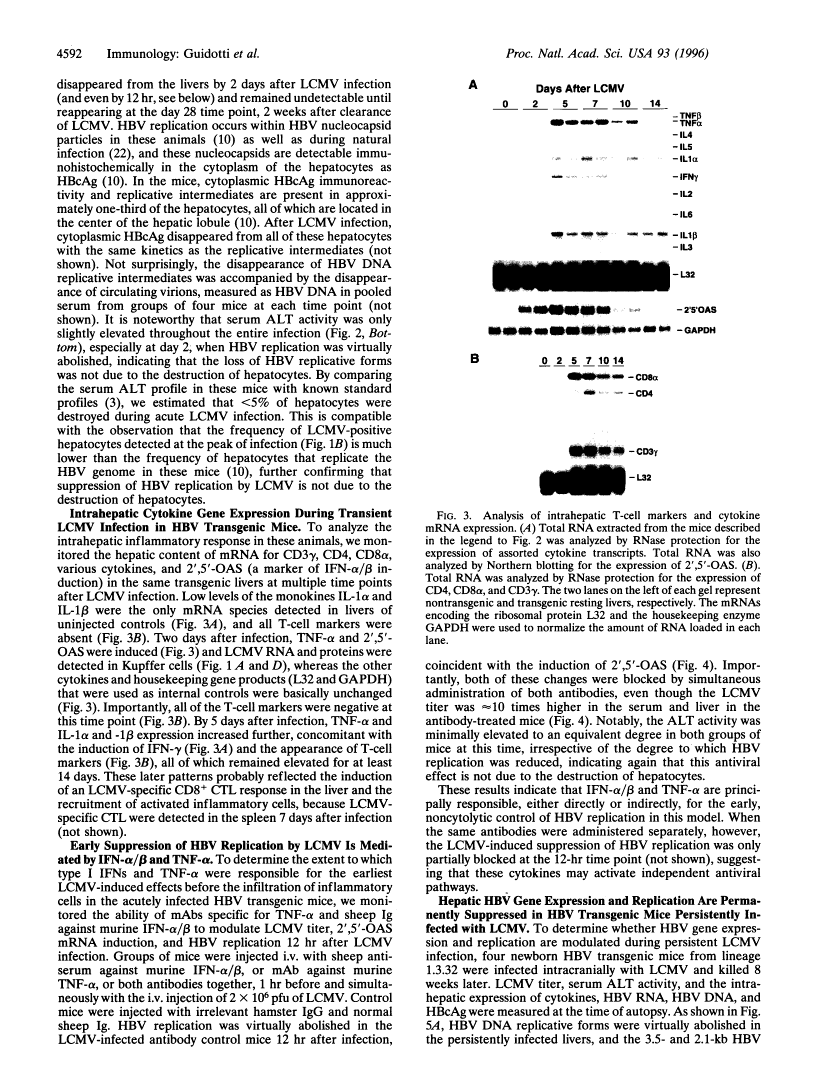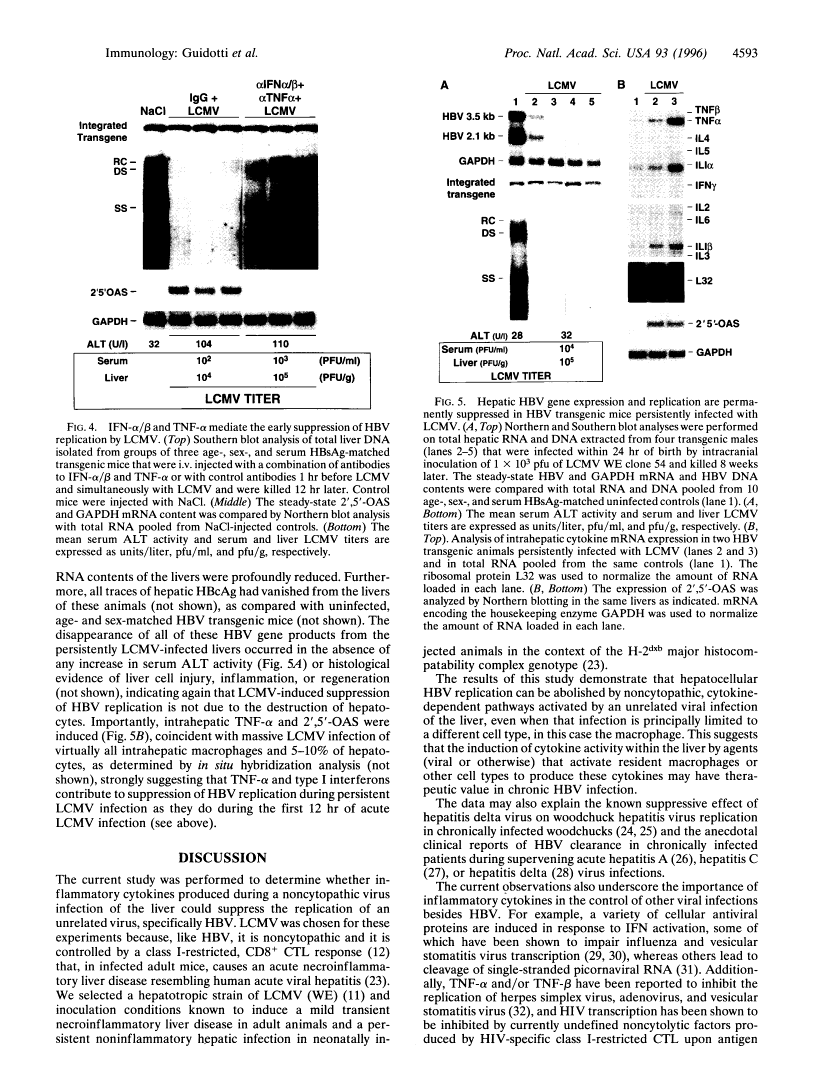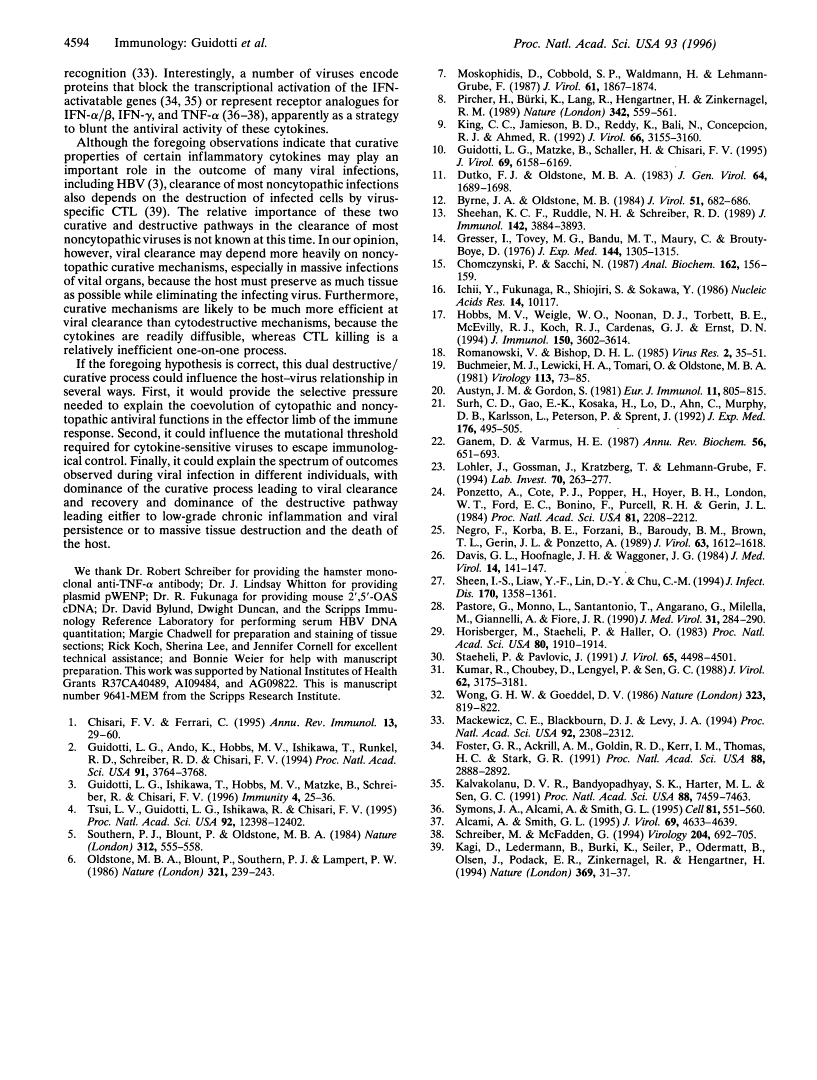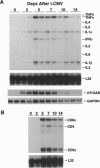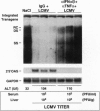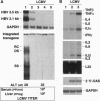Abstract
Free full text

Viral cross talk: intracellular inactivation of the hepatitis B virus during an unrelated viral infection of the liver.
Abstract
Hepatitis B virus (HBV) infection is thought to be controlled by virus-specific cytotoxic T lymphocytes (CTL). We have recently shown that HBV-specific CTL can abolish HBV replication noncytopathically in the liver of transgenic mice by secreting tumor necrosis factor alpha (TNF-alpha) and interferon gamma (IFN-gamma) after antigen recognition. We now demonstrate that hepatocellular HBV replication is also abolished noncytopathically during lymphocytic choriomeningitis virus (LCMV) infection, and we show that this process is mediated by TNF-alpha and IFN-alpha/beta produced by LCMV-infected hepatic macrophages. These results confirm the ability of these inflammatory cytokines to abolish HBV replication; they elucidate the mechanism likely to be responsible for clearance of HBV in chronically infected patients who become superinfected by other hepatotropic viruses; they suggest that pharmacological activation of intrahepatic macrophages may have therapeutic value in chronic HBV infection; and they raise the possibility that conceptually similar events may be operative in other viral infections as well.
Full text
Full text is available as a scanned copy of the original print version. Get a printable copy (PDF file) of the complete article (2.5M), or click on a page image below to browse page by page. Links to PubMed are also available for Selected References.
Images in this article
Click on the image to see a larger version.
Selected References
These references are in PubMed. This may not be the complete list of references from this article.
- Chisari FV, Ferrari C. Hepatitis B virus immunopathogenesis. Annu Rev Immunol. 1995;13:29–60. [Abstract] [Google Scholar]
- Guidotti LG, Ando K, Hobbs MV, Ishikawa T, Runkel L, Schreiber RD, Chisari FV. Cytotoxic T lymphocytes inhibit hepatitis B virus gene expression by a noncytolytic mechanism in transgenic mice. Proc Natl Acad Sci U S A. 1994 Apr 26;91(9):3764–3768. [Europe PMC free article] [Abstract] [Google Scholar]
- Guidotti LG, Ishikawa T, Hobbs MV, Matzke B, Schreiber R, Chisari FV. Intracellular inactivation of the hepatitis B virus by cytotoxic T lymphocytes. Immunity. 1996 Jan;4(1):25–36. [Abstract] [Google Scholar]
- Tsui LV, Guidotti LG, Ishikawa T, Chisari FV. Posttranscriptional clearance of hepatitis B virus RNA by cytotoxic T lymphocyte-activated hepatocytes. Proc Natl Acad Sci U S A. 1995 Dec 19;92(26):12398–12402. [Europe PMC free article] [Abstract] [Google Scholar]
- Southern PJ, Blount P, Oldstone MB. Analysis of persistent virus infections by in situ hybridization to whole-mouse sections. Nature. 1984 Dec 6;312(5994):555–558. [Abstract] [Google Scholar]
- Oldstone MB, Blount P, Southern PJ, Lampert PW. Cytoimmunotherapy for persistent virus infection reveals a unique clearance pattern from the central nervous system. Nature. 1986 May 15;321(6067):239–243. [Abstract] [Google Scholar]
- Moskophidis D, Cobbold SP, Waldmann H, Lehmann-Grube F. Mechanism of recovery from acute virus infection: treatment of lymphocytic choriomeningitis virus-infected mice with monoclonal antibodies reveals that Lyt-2+ T lymphocytes mediate clearance of virus and regulate the antiviral antibody response. J Virol. 1987 Jun;61(6):1867–1874. [Europe PMC free article] [Abstract] [Google Scholar]
- Pircher H, Bürki K, Lang R, Hengartner H, Zinkernagel RM. Tolerance induction in double specific T-cell receptor transgenic mice varies with antigen. Nature. 1989 Nov 30;342(6249):559–561. [Abstract] [Google Scholar]
- King CC, Jamieson BD, Reddy K, Bali N, Concepcion RJ, Ahmed R. Viral infection of the thymus. J Virol. 1992 May;66(5):3155–3160. [Europe PMC free article] [Abstract] [Google Scholar]
- Guidotti LG, Matzke B, Schaller H, Chisari FV. High-level hepatitis B virus replication in transgenic mice. J Virol. 1995 Oct;69(10):6158–6169. [Europe PMC free article] [Abstract] [Google Scholar]
- Dutko FJ, Oldstone MB. Genomic and biological variation among commonly used lymphocytic choriomeningitis virus strains. J Gen Virol. 1983 Aug;64(Pt 8):1689–1698. [Abstract] [Google Scholar]
- Byrne JA, Oldstone MB. Biology of cloned cytotoxic T lymphocytes specific for lymphocytic choriomeningitis virus: clearance of virus in vivo. J Virol. 1984 Sep;51(3):682–686. [Europe PMC free article] [Abstract] [Google Scholar]
- Sheehan KC, Ruddle NH, Schreiber RD. Generation and characterization of hamster monoclonal antibodies that neutralize murine tumor necrosis factors. J Immunol. 1989 Jun 1;142(11):3884–3893. [Abstract] [Google Scholar]
- Gresser I, Tovey MG, Bandu ME, Maury C, Brouty-Boyé D. Role of interferon in the pathogenesis of virus diseases in mice as demonstrated by the use of anti-interferon serum. I. Rapid evolution of encephalomyocarditis virus infection. J Exp Med. 1976 Nov 2;144(5):1305–1315. [Europe PMC free article] [Abstract] [Google Scholar]
- Chomczynski P, Sacchi N. Single-step method of RNA isolation by acid guanidinium thiocyanate-phenol-chloroform extraction. Anal Biochem. 1987 Apr;162(1):156–159. [Abstract] [Google Scholar]
- Ichii Y, Fukunaga R, Shiojiri S, Sokawa Y. Mouse 2-5A synthetase cDNA: nucleotide sequence and comparison to human 2-5A synthetase. Nucleic Acids Res. 1986 Dec 22;14(24):10117–10117. [Europe PMC free article] [Abstract] [Google Scholar]
- Hobbs MV, Weigle WO, Noonan DJ, Torbett BE, McEvilly RJ, Koch RJ, Cardenas GJ, Ernst DN. Patterns of cytokine gene expression by CD4+ T cells from young and old mice. J Immunol. 1993 Apr 15;150(8 Pt 1):3602–3614. [Abstract] [Google Scholar]
- Romanowski V, Bishop DH. Conserved sequences and coding of two strains of lymphocytic choriomeningitis virus (WE and ARM) and Pichinde arenavirus. Virus Res. 1985 Feb;2(1):35–51. [Abstract] [Google Scholar]
- Buchmeier MJ, Lewicki HA, Tomori O, Oldstone MB. Monoclonal antibodies to lymphocytic choriomeningitis and pichinde viruses: generation, characterization, and cross-reactivity with other arenaviruses. Virology. 1981 Aug;113(1):73–85. [Abstract] [Google Scholar]
- Austyn JM, Gordon S. F4/80, a monoclonal antibody directed specifically against the mouse macrophage. Eur J Immunol. 1981 Oct;11(10):805–815. [Abstract] [Google Scholar]
- Surh CD, Gao EK, Kosaka H, Lo D, Ahn C, Murphy DB, Karlsson L, Peterson P, Sprent J. Two subsets of epithelial cells in the thymic medulla. J Exp Med. 1992 Aug 1;176(2):495–505. [Europe PMC free article] [Abstract] [Google Scholar]
- Ganem D, Varmus HE. The molecular biology of the hepatitis B viruses. Annu Rev Biochem. 1987;56:651–693. [Abstract] [Google Scholar]
- Löhler J, Gossmann J, Kratzberg T, Lehmann-Grube F. Murine hepatitis caused by lymphocytic choriomeningitis virus. I. The hepatic lesions. Lab Invest. 1994 Feb;70(2):263–278. [Abstract] [Google Scholar]
- Ponzetto A, Cote PJ, Popper H, Hoyer BH, London WT, Ford EC, Bonino F, Purcell RH, Gerin JL. Transmission of the hepatitis B virus-associated delta agent to the eastern woodchuck. Proc Natl Acad Sci U S A. 1984 Apr;81(7):2208–2212. [Europe PMC free article] [Abstract] [Google Scholar]
- Negro F, Korba BE, Forzani B, Baroudy BM, Brown TL, Gerin JL, Ponzetto A. Hepatitis delta virus (HDV) and woodchuck hepatitis virus (WHV) nucleic acids in tissues of HDV-infected chronic WHV carrier woodchucks. J Virol. 1989 Apr;63(4):1612–1618. [Europe PMC free article] [Abstract] [Google Scholar]
- Davis GL, Hoofnagle JH, Waggoner JG. Acute type A hepatitis during chronic hepatitis B virus infection: association of depressed hepatitis B virus replication with appearance of endogenous alpha interferon. J Med Virol. 1984;14(2):141–147. [Abstract] [Google Scholar]
- Pastore G, Monno L, Santantonio T, Angarano G, Milella M, Giannelli A, Fiore JR. Hepatitis B virus clearance from serum and liver after acute hepatitis delta virus superinfection in chronic HBsAg carriers. J Med Virol. 1990 Aug;31(4):284–290. [Abstract] [Google Scholar]
- Horisberger MA, Staeheli P, Haller O. Interferon induces a unique protein in mouse cells bearing a gene for resistance to influenza virus. Proc Natl Acad Sci U S A. 1983 Apr;80(7):1910–1914. [Europe PMC free article] [Abstract] [Google Scholar]
- Staeheli P, Pavlovic J. Inhibition of vesicular stomatitis virus mRNA synthesis by human MxA protein. J Virol. 1991 Aug;65(8):4498–4501. [Europe PMC free article] [Abstract] [Google Scholar]
- Kumar R, Choubey D, Lengyel P, Sen GC. Studies on the role of the 2'-5'-oligoadenylate synthetase-RNase L pathway in beta interferon-mediated inhibition of encephalomyocarditis virus replication. J Virol. 1988 Sep;62(9):3175–3181. [Europe PMC free article] [Abstract] [Google Scholar]
- Wong GH, Goeddel DV. Tumour necrosis factors alpha and beta inhibit virus replication and synergize with interferons. Nature. 323(6091):819–822. [Abstract] [Google Scholar]
- Mackewicz CE, Blackbourn DJ, Levy JA. CD8+ T cells suppress human immunodeficiency virus replication by inhibiting viral transcription. Proc Natl Acad Sci U S A. 1995 Mar 14;92(6):2308–2312. [Europe PMC free article] [Abstract] [Google Scholar]
- Foster GR, Ackrill AM, Goldin RD, Kerr IM, Thomas HC, Stark GR. Expression of the terminal protein region of hepatitis B virus inhibits cellular responses to interferons alpha and gamma and double-stranded RNA. Proc Natl Acad Sci U S A. 1991 Apr 1;88(7):2888–2892. [Europe PMC free article] [Abstract] [Google Scholar]
- Kalvakolanu DV, Bandyopadhyay SK, Harter ML, Sen GC. Inhibition of interferon-inducible gene expression by adenovirus E1A proteins: block in transcriptional complex formation. Proc Natl Acad Sci U S A. 1991 Sep 1;88(17):7459–7463. [Europe PMC free article] [Abstract] [Google Scholar]
- Symons JA, Alcamí A, Smith GL. Vaccinia virus encodes a soluble type I interferon receptor of novel structure and broad species specificity. Cell. 1995 May 19;81(4):551–560. [Abstract] [Google Scholar]
- Alcamí A, Smith GL. Vaccinia, cowpox, and camelpox viruses encode soluble gamma interferon receptors with novel broad species specificity. J Virol. 1995 Aug;69(8):4633–4639. [Europe PMC free article] [Abstract] [Google Scholar]
- Schreiber M, McFadden G. The myxoma virus TNF-receptor homologue (T2) inhibits tumor necrosis factor-alpha in a species-specific fashion. Virology. 1994 Nov 1;204(2):692–705. [Abstract] [Google Scholar]
- Kägi D, Ledermann B, Bürki K, Seiler P, Odermatt B, Olsen KJ, Podack ER, Zinkernagel RM, Hengartner H. Cytotoxicity mediated by T cells and natural killer cells is greatly impaired in perforin-deficient mice. Nature. 1994 May 5;369(6475):31–37. [Abstract] [Google Scholar]
Associated Data
Articles from Proceedings of the National Academy of Sciences of the United States of America are provided here courtesy of National Academy of Sciences
Full text links
Read article at publisher's site: https://doi.org/10.1073/pnas.93.10.4589
Read article for free, from open access legal sources, via Unpaywall:
https://europepmc.org/articles/pmc39321?pdf=render
Citations & impact
Impact metrics
Article citations
Fighting fire with fire: using infectious agents to treat persistent infection.
Future Microbiol, 19(13):1177-1184, 06 Aug 2024
Cited by: 0 articles | PMID: 39105632
Review
Identification and distribution of pathogens coinfecting with Brucella spp., Coxiella burnetii and Rift Valley fever virus in humans, livestock and wildlife.
Zoonoses Public Health, 69(3):175-194, 15 Jan 2022
Cited by: 9 articles | PMID: 35034427 | PMCID: PMC9303618
Review Free full text in Europe PMC
Persistent RNA virus infection is short-lived at the single-cell level but leaves transcriptomic footprints.
J Exp Med, 218(10):e20210408, 16 Aug 2021
Cited by: 3 articles | PMID: 34398180 | PMCID: PMC8493862
β-Catenin Signaling Regulates the In Vivo Distribution of Hepatitis B Virus Biosynthesis across the Liver Lobule.
J Virol, 95(20):e0078021, 28 Jul 2021
Cited by: 4 articles | PMID: 34319157 | PMCID: PMC8475508
Macrophage Phenotypes and Hepatitis B Virus Infection.
J Clin Transl Hepatol, 8(4):424-431, 10 Oct 2020
Cited by: 19 articles | PMID: 33447526 | PMCID: PMC7782119
Review Free full text in Europe PMC
Go to all (126) article citations
Similar Articles
To arrive at the top five similar articles we use a word-weighted algorithm to compare words from the Title and Abstract of each citation.
Nitric oxide inhibits hepatitis B virus replication in the livers of transgenic mice.
J Exp Med, 191(7):1247-1252, 01 Apr 2000
Cited by: 80 articles | PMID: 10748242 | PMCID: PMC2193173
Relative sensitivity of hepatitis B virus and other hepatotropic viruses to the antiviral effects of cytokines.
J Virol, 74(5):2255-2264, 01 Mar 2000
Cited by: 170 articles | PMID: 10666256 | PMCID: PMC111707
Noncytopathic clearance of lymphocytic choriomeningitis virus from the hepatocyte.
J Exp Med, 189(10):1555-1564, 01 May 1999
Cited by: 93 articles | PMID: 10330434 | PMCID: PMC2193644
Hepatitis B virus immunopathogenesis.
Annu Rev Immunol, 13:29-60, 01 Jan 1995
Cited by: 978 articles | PMID: 7612225
Review
Funding
Funders who supported this work.
NCI NIH HHS (1)
Grant ID: R37CA40489
NIA NIH HHS (1)
Grant ID: AG09822
NIAID NIH HHS (1)
Grant ID: AI09484
